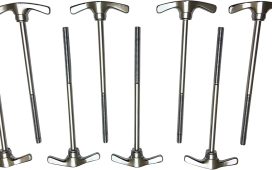Pallet loads are crucial in every logistic stage of the business – both storing and handling within the warehouse and transport stage. Pallets are available in different shapes and dimensions. However, there is a universal standard measurement adapted for industrial racking, forklifts, and even pallet handling equipment like pallet inverters or sliders.
Pallet racking is a pallet grouping system that allows the warehouse to save space and control stock turnover. Some benefits of pallet racking are –
- Loading & unloading time optimization.
- Facilitates better use of available warehouse space.
- Flexibility for handling & transport.
- Product transport is made easy.
- Control inventory & stock with ease.
- Lessens the handling, storage, and transport costs.
For easy access to unit loads, the warehouse owners need to consider the product type to store, stock rotation, inventory management routine, etc. There is also a need to identify the kind of pallet handling equipment to invest in. TopIndustries are the best pallet inverter, manufacturers. You can approach them and discuss what kind of pallet changer is suitable because if they don’t have they can customize a suitable one.
Common pallet racking types
Adjustable pallet racking
It is a simple and common pallet racking system. It is designed to store pallets mechanically with forklifts that operate parallel to racking rows. The system is not compact and needs wide floor space to install. It offers quick and direct access to all stored unit loads. It is adaptable and versatile.
VNA [very narrow aisle] racking
It is an easygoing version of the adjustable pallet racking solution. The available warehouse space is put to better use. The work aisle width is reduced, so it needs less space for installation. Direct access for storing and retrieving unit load is maintained. Nevertheless, VNA racking will need forklifts with a narrow aisle to operate and move around.
Double deep pallet racking
It is also a modified version focused on increasing storage capacity. An extra position is added for pallets, at the racking’s back side. The unit load stores at double depth. It is a system that increases storage capacity but the drawback is direct access to every unit load.
Drive in/through compact racking
It is a high-density system that enhances the available space. There are no aisles and the forklift directly enters inside the racking layout for stacking or retrieving the unit loads. The system works on the concept of LIFO [Live Storage for Pallets]. It is a system having one entry & exit aisle for the forklift. FIFO or first in first out method is used to load and unload the pallets.
FIFO Live Storage for pallets
It is a compact structure having roller lines with a downward inclination for moving pallets from one end to another. It uses the FIFO method, which allows ideal stock rotation.
Push-back pallet racking
The structure is similar to FIFO live storage, but here the storage uses LIFO or the Last in, first out method. Forklifts load new pallets and push the previous ones to the back. The system has lines of trolleys and rollers that work on the pushing principle.
Mobile pallet racking
It is a structure installed beside some chassis and rail guides on the floor enabling lateral displacement of racking modules. Work aisles open and allow forklifts to operate.
Check TopIndustries YouTube videos to find out how their pallet inverters work with the racking system in warehouses.







